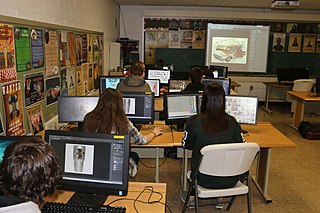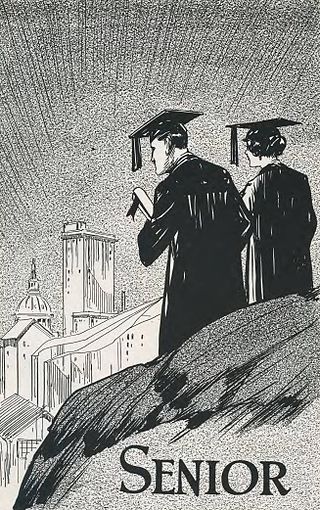Education in Quebec is governed by the Ministry of Education and Higher Education. It was administered at the local level by publicly elected French and English school boards, changed in 2020 to school service centres. Teachers are represented by province-wide unions that negotiate province-wide working conditions with local boards and the provincial government of Quebec.

A student is a person enrolled in a school or other educational institution.

A CEGEP is a publicly funded college providing technical, academic, vocational or a mix of programs; they are exclusive to the province of Quebec's education system. A loanword from French, it originates from the French acronym for collège d'enseignement général et professionnel, sometimes known in English as a "General and Vocational College"—it is now considered a word in itself.

Education in Canada is for the most part provided publicly, funded and overseen by federal, provincial, and local governments. Education is within provincial jurisdiction and the curriculum is overseen by the province. Education in Canada is generally divided into primary education, followed by secondary education and post-secondary. Education in both English and French is available in most places across Canada. Canada has a large number of universities, almost all of which are publicly funded. Established in 1663, Université Laval is the oldest post-secondary institution in Canada. The largest university is the University of Toronto with over 85,000 students. Four universities are regularly ranked among the top 100 world-wide, namely University of Toronto, University of British Columbia, McGill University, and McMaster University, with a total of 18 universities ranked in the top 500 worldwide.

The General Educational Development (GED) tests are a group of four academic subject tests in the United States and Canada certifying academic knowledge equivalent for a high school diploma. This certification is an alternative to the U.S. high school diploma, as is HiSET. Passing the GED test gives those who do not complete high school, or who do not meet requirements for high school diploma, the opportunity to earn a Certificate of High School Equivalency or similarly titled credential. GED Testing Service is a joint venture of the American Council on Education, which started the GED program in 1942.
The Ontario Academic Credit (OAC), which may also be known as 12b was a fifth year of secondary school education that previously existed in the province of Ontario, Canada, designed for students preparing for post-secondary education. The OAC curriculum was codified by the Ontario Ministry of Education in Ontario Schools: Intermediate and Senior (OS:IS) and its revisions. The Ontario education system had a final fifth year of secondary education, known as Grade 13 from 1921 to 1988; grade 13 was replaced by OAC for students starting high school in 1984. OAC continued to act as a fifth year of secondary education until it was phased out in 2003.

Matriculation is the formal process of entering a university, or of becoming eligible to enter by fulfilling certain academic requirements such as a matriculation examination.

Secondary education is the last six or seven years of statutory formal education in the United States. It culminates with twelfth grade. Whether it begins with sixth grade or seventh grade varies by state and sometimes by school district.

The Ontario Agricultural College (OAC) originated at the agricultural laboratories of the Toronto Normal School, and was officially founded in 1874 as an associate agricultural college of the University of Toronto. Since 1964, it has become affiliated with the University of Guelph, which operates campuses in Guelph and Ridgetown and formerly in Alfred and Kemptville, all in Ontario.

A state school, public school, or government school is a primary or secondary school that educates all students without charge. Such schools are funded in whole or in part by taxation and operated by the government of the state.

Twelfth grade is the twelfth year of formal or compulsory education. It is typically the final year of secondary school and K–12 in most parts of the world. Students in twelfth grade are usually 17–18 years old. Some countries have a thirteenth grade, while other countries do not have a 12th grade/year at all.
University admission or college admission is the process through which students enter tertiary education at universities and colleges. Systems vary widely from country to country, and sometimes from institution to institution.

Francis Libermann Catholic High School is a Catholic secondary school in Toronto, Ontario, Canada. It is located in the Agincourt neighbourhood of Scarborough, and part of the Toronto Catholic District School Board, formerly the Metropolitan Separate School Board.
Educational stages are subdivisions of formal learning, typically covering early childhood education, primary education, secondary education and tertiary education. The United Nations Educational, Scientific and Cultural Organization (UNESCO) recognizes nine levels of education in its International Standard Classification of Education (ISCED) system. UNESCO's International Bureau of Education maintains a database of country-specific education systems and their stages. Some countries divide levels of study into grades or forms for school children in the same year.

The American International School, Abu Dhabi is a private international K-12 school offering an American curriculum. The college-preparatory IB Diploma Program (IBDP) is offered in grades 11 and 12, and the IB Primary Years Program (IBPYP) is offered from KG to Grade 5. The school is coeducational in elementary, and gender-segregated in secondary.

Bayview Secondary School, initially known as Bayview High School is a grade 9–12, 2-semester secondary school operated by the York Region District School Board. It is located just north of the northeast corner of Bayview Avenue and Major Mackenzie Drive in Richmond Hill, Ontario, Canada. Bayview S.S. was officially opened on March 19, 1961.
Education in Ontario comprises public and private primary schools, secondary schools and post-secondary institutions. Publicly funded elementary and secondary schools are administered by the Ontario Ministry of Education, while colleges and universities are administered by the Ontario Ministry of Training, Colleges and Universities. The current respective Ministers for each are Stephen Lecce and Ross Romano. The province's public education system is primarily funded by the Government of Ontario, with education in Canada falling almost entirely under provincial jurisdiction. There is no federal government department or agency involved in the formation or analysis of policy regarding education for most Canadians. Schools for Indigenous people in Canada with Indian status are the only schools that are funded federally, and although the schools receive more money per individual student than certain provinces, the amount also includes the operation and maintenance of school facilities, instructional services, students supports and staff. Most provincial allocations per students do not include the maintenance and operation of buildings, as most provincial governments offer additional grants.

The term senior, in regard to education, has different meanings depending on the country.
A high school diploma is a diploma awarded upon graduation of high school. A high school diploma is awarded after completion of courses of studies lasting four years, typically from grade 9 to grade 12. It is the school leaving qualification in the United States and Canada.












